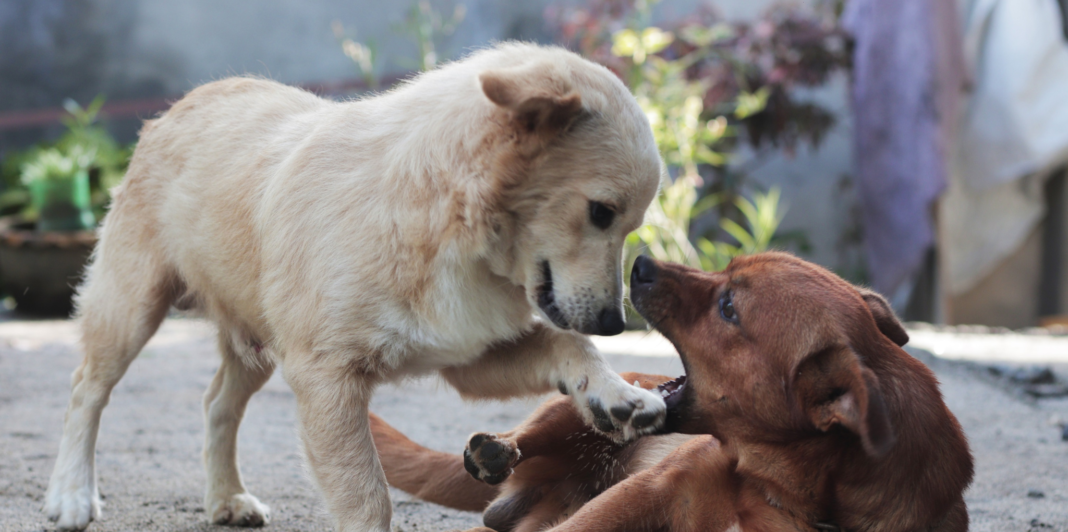Pets With A Mission, Inc.: Aggressive Pets
 Aggression. That is a word that causes concern, and even fear, in the hearts of pet owners, and the general public, when it is applied to dogs and other animals. The vast majority of people want to avoid choosing an aggressive puppy, kitten or older animal to adopt. Animals that show any aggressive tendencies often get turned into shelters. In many cases, the animals are just showing normal animal behaviors, even if their owners do not understand that. With a little education and some training, they could become excellent family pets. Aggression comes in many forms. Once, I brought home a three-month old, six pound corgi puppy who was food aggressive. If I did not put down her food bowl and move away fast enough, she would growl at me. Initially, I was worried that she would bite. Obviously that was not acceptable behavior. If I gave her the bowl and she growled, I immediately grabbed her collar and held her away from my hand as I took her bowl away. About five minutes later, I would try again. If she growled, the bowl went away again but if she was silent, the bowl stayed and she could eat. After a week, she no longer growled at mealtime. She learned what behavior was expected if she wanted food. This was a classic example of how a little knowledge and some training resolved a potentially dangerous situation. I took in a stray six month old kitten that showed up in my yard. He was a good guy most of the time but he had a tendency to bite. I believe he was dumped in our neighborhood because someone could not deal with the issue. He was still getting his adult teeth so that probably contributed to the situation. With consistent training, he learned not to bite and he became an excellent family pet. An eight week old bunny came home with me. She was a real sweetie except when I removed her bowls or if I tried to clean her cage. Then, she would launch herself at my hand with claws flying and teeth showing. I received some unpleasant bites and scratches until I learned how to handle her. As she started her attack, I pinned her to the bottom of the cage. Then, I put her on the floor to hop around while I cleaned her cage. I could not train her to be less aggressive for cage cleaning but I learned to manage the situation. There are two unrelated senior dogs who have lived together as sisters for many years. Ninety-nine percent of the time they get along well. But every once in a while, they get on each other’s nerves like many sisters do. Then, they fight. They get in each other’s faces and sound like they want to inflict damage to each other. The first time I saw them doing that, I expected the worse but I yelled at them to stop and they did. Luckily, their fights are only a little pushing and a lot of noise and never have become anything more. Telling them to stop works for the situation. Aggression comes in many forms that range from very minor to actions that could cause serious bodily injury. The examples demonstrated fairly minor aggression, but that is not always the case. When animals get jumped on by other animals, they may end up with nasty puncture wounds, ripped ears, damaged eyes, or worse. Sometimes, we hear media stories where a person was attacked, injured or killed by an animal. More often than not, the animal was a family pet or a neighbor’s animal who was running loose in the neighborhood. There are many reasons why animals become aggressive: fear, pain, illness, defending their territories, and abusive handling, among others. I knew a Rottweiler mix who was about eight years old when she starting jumping on the other family dogs. The incidents did not appear to have an obvious trigger. One minute she would be calm and friendly and the next she would attack. The pet parents tried additional training, behavior modification, and several different medications but nothing really helped. Then, they learned that she had a medical condition, a brain tumor, which caused her erratic and aggressive behavior. Far more often, though, aggression is caused by fear, real or imagined. The fearful animal may become aggressive if they cannot escape from the thing that is causing their fear. Recently, I was out in the front yard and I saw two cats in a nearby yard. Things were fine until they were not. The two tom cats yowled, became entangled and rolled around on the ground fighting, apparently over territory. It looked like one or both of them would be seriously hurt. A neighbor near the fighting cats moved toward them, yelled, and clapped his hands. That startled the cats, caused them to separate, and they ran in opposite directions. It was a scary situation but the aggression was averted for at least a while. I will be the first to admit that I do not have the knowledge or skills necessary to handle truly aggressive animals. There are a few highly aggressive animals who cannot safely live with humans ever. There are also some less aggressive animals who might become reliably safe around people and other animals but those animals would need the services of an animal behaviorist or a specialized animal trainer and months of extensive training to possibly reach that point. Most of us are not willing to take on that type of project. That leaves us with a larger pool of animals with minor aggression issues who could become excellent family pets with additional training. Please take a chance on one of those less than perfect pets. With time and consistent training, they can learn what is expected of them and become the perfect pet for your family.
Aggression. That is a word that causes concern, and even fear, in the hearts of pet owners, and the general public, when it is applied to dogs and other animals. The vast majority of people want to avoid choosing an aggressive puppy, kitten or older animal to adopt. Animals that show any aggressive tendencies often get turned into shelters. In many cases, the animals are just showing normal animal behaviors, even if their owners do not understand that. With a little education and some training, they could become excellent family pets. Aggression comes in many forms. Once, I brought home a three-month old, six pound corgi puppy who was food aggressive. If I did not put down her food bowl and move away fast enough, she would growl at me. Initially, I was worried that she would bite. Obviously that was not acceptable behavior. If I gave her the bowl and she growled, I immediately grabbed her collar and held her away from my hand as I took her bowl away. About five minutes later, I would try again. If she growled, the bowl went away again but if she was silent, the bowl stayed and she could eat. After a week, she no longer growled at mealtime. She learned what behavior was expected if she wanted food. This was a classic example of how a little knowledge and some training resolved a potentially dangerous situation. I took in a stray six month old kitten that showed up in my yard. He was a good guy most of the time but he had a tendency to bite. I believe he was dumped in our neighborhood because someone could not deal with the issue. He was still getting his adult teeth so that probably contributed to the situation. With consistent training, he learned not to bite and he became an excellent family pet. An eight week old bunny came home with me. She was a real sweetie except when I removed her bowls or if I tried to clean her cage. Then, she would launch herself at my hand with claws flying and teeth showing. I received some unpleasant bites and scratches until I learned how to handle her. As she started her attack, I pinned her to the bottom of the cage. Then, I put her on the floor to hop around while I cleaned her cage. I could not train her to be less aggressive for cage cleaning but I learned to manage the situation. There are two unrelated senior dogs who have lived together as sisters for many years. Ninety-nine percent of the time they get along well. But every once in a while, they get on each other’s nerves like many sisters do. Then, they fight. They get in each other’s faces and sound like they want to inflict damage to each other. The first time I saw them doing that, I expected the worse but I yelled at them to stop and they did. Luckily, their fights are only a little pushing and a lot of noise and never have become anything more. Telling them to stop works for the situation. Aggression comes in many forms that range from very minor to actions that could cause serious bodily injury. The examples demonstrated fairly minor aggression, but that is not always the case. When animals get jumped on by other animals, they may end up with nasty puncture wounds, ripped ears, damaged eyes, or worse. Sometimes, we hear media stories where a person was attacked, injured or killed by an animal. More often than not, the animal was a family pet or a neighbor’s animal who was running loose in the neighborhood. There are many reasons why animals become aggressive: fear, pain, illness, defending their territories, and abusive handling, among others. I knew a Rottweiler mix who was about eight years old when she starting jumping on the other family dogs. The incidents did not appear to have an obvious trigger. One minute she would be calm and friendly and the next she would attack. The pet parents tried additional training, behavior modification, and several different medications but nothing really helped. Then, they learned that she had a medical condition, a brain tumor, which caused her erratic and aggressive behavior. Far more often, though, aggression is caused by fear, real or imagined. The fearful animal may become aggressive if they cannot escape from the thing that is causing their fear. Recently, I was out in the front yard and I saw two cats in a nearby yard. Things were fine until they were not. The two tom cats yowled, became entangled and rolled around on the ground fighting, apparently over territory. It looked like one or both of them would be seriously hurt. A neighbor near the fighting cats moved toward them, yelled, and clapped his hands. That startled the cats, caused them to separate, and they ran in opposite directions. It was a scary situation but the aggression was averted for at least a while. I will be the first to admit that I do not have the knowledge or skills necessary to handle truly aggressive animals. There are a few highly aggressive animals who cannot safely live with humans ever. There are also some less aggressive animals who might become reliably safe around people and other animals but those animals would need the services of an animal behaviorist or a specialized animal trainer and months of extensive training to possibly reach that point. Most of us are not willing to take on that type of project. That leaves us with a larger pool of animals with minor aggression issues who could become excellent family pets with additional training. Please take a chance on one of those less than perfect pets. With time and consistent training, they can learn what is expected of them and become the perfect pet for your family.















